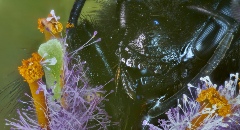
2024 © All copyright is reserved, reproduction is prohibited


Who
Whilst many insects may ...err ‘bug’ us there is no denying their extraordinary variety and that without them life on this planet would certainly not include us.
The reason for this project is to highlight some of the amazing insects that exist in our backyards. It is also to highlight what we have lost and thereby promote better understanding and hopefully more care of our environment.
Hopefully seeing the extinct and stunning Lycaena Dispar Diaspar will make you, at least a little angry that we lost this amazing butterfly. No one will ever be able to see it fluttering in its natural fen habitat ever again. Sadly we are loosing species every year and need to do so much more to protect their and by extension our environment.
Disabled guy who occasionally feels well enough to take pictures and his amazing wife who does everything else including all the web stuff, promotion, prints, licensing, sales etc
How
Just a quick snap ..right?
Err No. These photographs are the result of many weeks of very exacting photography. Each image you are zooming into is the result of many thousands of photographs.
The process starts with photographing only a small section of the insect. Each photo is taken a set number of microns, generally 10 microns apart. This results in hundreds of photographs per portion of insect. This number of photographs is required, as at the magnifications used, only a very thin slice of the insect is in focus per photograph. Much like assembling a salami from its slices these photographs then need to be stacked together to bring all the sections into focus. Once processed and then stacked, this results in one section of the insect.
The process then needs to be repeated for each section of the insect creating a mosaic of images. Much like a jigsaw puzzle this then needs to be brought together to create the final image. Obviously this is a vast oversimplification however this is the basic process.
The data collected can easily run into a Terabyte per end picture of the insect.
However the final image is only a few gigabytes but can easily exceed giga-
Why
